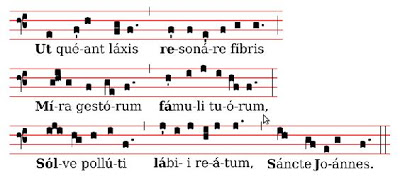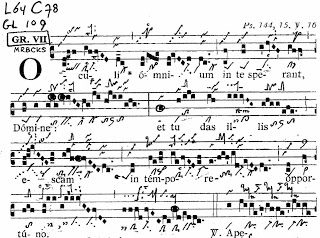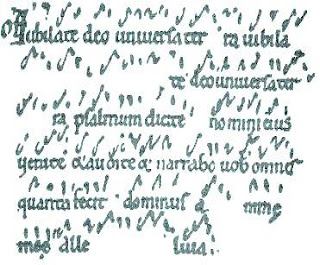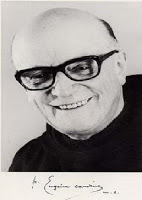By the 11th Century the basic corpus of Gregorian Chants as we now have them, with the exception of chants for more recent feasts, was complete. At that time there was no system of musical notation and the chants were committed to memory – an enormous task, given the entire body of Chant exceeds in length the entire works of Wagner!

However, in certain manuscripts we find quasi-musical markings above the Latin (and Greek) texts which indicate the rise and fall of the melody – these symbols resemble, at their most basic level, the grave and acute accents in French. They also give us considerable information regarding the rhythm of the chants. The study of these signs and symbols is known as Semiology. It is from these symbols that the modern system of Western musical notation grew, thanks to the Benedictine Monk Guido d’ Arezzo (c990 – 1050). It is he who invented staff notation, initially by grouping neumes around a single line, which he then increased to four. He also assigned each ‘pitch’ a name – Ut, Re, Mi, Fa, Sol, La – having noticed that the first note of each phrase of the hymn to St John the Baptist (Ut queant laxis) begins on a note one step higher in pitch than the last.

He used the first syllable of each phrase to name the pitches. It is from this system that we get the Tonic Sol Fa system – the Ut was replaced by Do, and Si or Ti was added later (Ut, a deer, a female deer doesn’t sound quite right!)
However, whilst there were considerable advantages to Guido’s system of notation – that of precisely indicating relative, if not absolute, pitch for the first time – the simplification of the neumatic symbols that accompanied the new system meant that the rhythmic nuances contained within the original unheighted neumes was lost and the new system became an indicator of pitch alone. A glance at the following scan from the Graduale Triplex will suffice to confirm this – observe the careful detail of the unheighted neumes as opposed to the rather lumpy, square notation with which we are more familiar, and which lacks the ability to express rhythmic subtlety in any way.

Various theories have been proposed regarding the rhythm of the Chant over the past 100 or so years, the old Solesmes Method having dominated almost all performances of the Chant for the past 80 years and is still reigning supreme. However, the ground-breaking work of Dom Eugene Cardine, a monk of Solesmes, in trying to unlock the rhythmic significance of the original neumes, has raised new questions about the way in which we perform the Chant, and has taken us back to Dom Guéranger’s original assertion, that the text must come first.
In his monumental study Gregorian Semiology, Cardine explains the function of unheighted neumes in terms of the information they impart regarding approximate pitch. However, through extensive study of different manuscripts and the different neumatic symbols of various notational traditions, he attempts to unlock the rhythmic significance of the neumes, and his theories, whilst still theories and not facts, are nonetheless extremely convincing, and are supported by evidence contained within the various notations used in France

The result, perhaps most clearly seen in Dom Saulnier’s new Antiphonale Monasticum, is the removal of editorial rhythmic symbols associated with the old Solesmes Method, including the lengthening dots and most episemas, and the creation of ‘new’ neumes based on old unheighted neumes, intended to convey some subtle rhythmic nuance which the current quadratic notation cannot convey. The theories regarding the episema, the quilisma and the salicus etc have the effect of liberating the Chant from a dogged, overly-metrical style of performance and allowing the words, once more, to take precedence. As Cardinal Garonne reminds us, in the Chant “the words almost give forth the music they already possess”, a point understood only too well by Guéranger, Cardine and his successor, Saulnier.

Over the coming weeks I will present a series of short articles on the main notational symbols used in the Chant, and attempt to outline in simple fashion Dom Cardine’s theories of rhythmic performance based on his study of the earliest manuscripts of unheighted neumatic notation. However, for those of you who wish to undertake a more detailed study, I recommend Cardine’s Book Gregorian Semiology and, of course, the Graduale Triplex, an indispensable volume for the true Gregorian enthusiast! I should point out, as I close this introductory piece, that the theories outlined above are just that – theories. It is easy to be dogmatic about such things and, whilst I am a disciple of Cardine and his theories, others are not. I merely offer these thoughts as one of many possible interpretations of the Chant we know and love.
Nick Gale, June 2010

Great post! Learning from Dom Saulnier was for me a liberating experience and convinced me of the necessity of singing chant.
Wonderful blog.
Can I suggest perhaps some fine background chant to enhance things while reading?
I'm really looking forward to your series, Nick!
Guido is given credit for the musical staff and for solfege, but one must keep in mind the medieval desire to attribute such things to a single person. Just look at the notion of "Gregorian" chant. Not to take away his importance in the matter, but I'd just like to note that the use of a single red line for Ut and a green line for Fa existed before Guido. We can more rightly attribute the final form of solfege to him since the hymn "Ut queant laxis" seems to have not existed prior to his use of it for pedagogical purposes. It's not a stretch to suggest that he wrote the hymn specifically to teach his system. Great article. I'm looking forward to learning more about Cardine.
I'm looking forward to learning more about Cardine's approach.
I'm not sure if you will cover it but something I've wondered for a while is what one does with ones singers practically, to get a uniform performance, how does one direct, teach a new chant ect.?
This comment has been removed by the author.
Anon, I am trying to work out a way of uploading some music! Forgive my virginal approach to blogging! Michael, I agree with your comments. Thanks. Adam and Francis, thanks! ben, I will deal with that towards the end of the series – mainly by describing how I deal with it every Sunday at the Cathedral.
Thank you so much for this post. I know you don't intend this as a blogged seminar, but one question that has always vexed me about this claim that the text always comes first. Namely: what about music in which the text clearly does not come first? I'm thinking, for example, of most Gradual chants and e.g. offertory verses with melismas of up to 50 plus notes. Would you say that the text comes first except when it does not? Or does the rule of good sense apply in here, that is to say, when the text is primary we need a method and approach that permits it to really be primary? I mean, I think I understand the point about text and it always improves my singing to understand this point but there are many cases when the text is just a very very long vowel. How can there really be universal principles concerning the debate between text and music when their relative importance to the chant ebbs and flows depending on the piece of music?
Jeffrey–I look forward to hearing how Nick addresses this in his series, but preliminarily I could say this:
Your question deals with the departure of chant as a "speech like declamation" to the highly ornamented forms like a gradual.
Firstly, semiology shows that the units that form these melismas are the same units that are commonly used in the syllabic/neumatic idioms, they're just strung together. So in this sense, melismas are treated much the same as a Communio proper.
Secondly, I think the "text comes first" idea is often misunderstood. The idea that we could squeeze 50 notes into a syllable in the time it would take it speak it is absurd. The point is that the integrity of the text spoken text is in tact and well represented. Melismas have specific purposes then, which are dealing with a heightening of the words, a transcendence which intentionally lifts us out of any idea of "ordinary speech".
I will leave it to Nick to illuminate this more, but I think that Cardine makes a lot of important very revelatory points about the way that everything in chant exists to serve the declamation of the liturgical text, the Word of God Incarnate, the Voice of Christ acting in the liturgy. There's an Incarnational Theology that's revealed here that goes much much farther than the pragmatism of musical practice.
But that's another post…
I made a typo in the last comment, which is probably the most important line. It should read:
"The point is that the integrity of the spoken text is in tact and well represented."
All that sounds great. I don't see how that is different from what Mocq and Gajard said but an insight is an insight from whatever source. Thank you!
Thanks for your constructive remarks Jeffrey, and well said Adam, I agree totally. All I would add is that the melisma is seen as a 'reflection' or 'meditation' on an individual syllable, a moment of 'pure music', as Saulnier describes it, where the singer decorates and embellishes. He claims it has its origins in improvised song and, thus, I would draw an analogy (bizarrely!) with scat singing in jazz, or in improvised ecstatic song in charismatic worship. Sensitively performed, the melisma does actually highlight the text in almost all cases.
I see no conflict with this interpretation and the primacy of the text. Where I would agree with the text playing second fiddle is in strophic hymns used in the office, where the music remains the same and the text varies.
Thanks for all comments on this article. It is extremely useful to have feedback and constructive criticism.
You know, Christopher Page's new book talks at length about the rise of the great cantor in the earliest centuries and reports in detail about their capacity to astound people with their luxurious improvisations, which were undoubtedly copied by others in this audio-centric culture (if it could happen with 1950s bob, it could happen in the 6 and 7th centuries too and more so). This was surely the origin of these great pieces. Wonderful to think of.
I can't wait to read it! As to the difference between Saulnier/Cardine and Gajard/Mocq, it is in the specific interpretation of neumatic signs, the role of the episema, the purpose of the quilisma, the salicus etc. It is not so much a general principle as a specific manner of interpreting individual signs, so more will become clear as different neumes are considered. I hope!!
When I was in the Benedictine novitiate I was taught by a dear father who was an inspiring pedagogue and a fine musician, but the interpretative framework he passed onto us was one that I found counter-intuitive at the time & would find stifling now. I have on the desk in front of me (I happened to find it while sorting papers this afternoon) the notes I took at the time. 'The note is doubled in duration in the following cases: (1) punctum with ictus & episema; (2) punctum with dot; (3) virga with dot; (4) middle note of a salicus; (5) distropha (tripled for tristropha); (6) note before a quilisma; (7) punctum with episema if occuring in final syllable of a word; (8) virga with episema in final syllable; (9) 'overlined' neum, though this should be 'broadened' rather than lengthened.'
Now, some of these lengthenings will be observed whether one is a Gajardist or a Cardinist, but the point is that in this method, as taught to me, these rules were to be observed *regardless of the text*. The emphasis was all on note-duration rather than accent – as if one were trying to scan accentual English poetry according to the quantitative rules of classical Latin verse. Maybe if I'd stayed in the monastery a bit longer, Father would have led me on to a more nuanced reading of the chant! But Chant 101 – in the form in which I encountered it – seemed to me to be leading away from the text & towards rigid & arbitrary rhythmic rules. This is why I was very glad to be introduced to Cardine's approach by Nick on a recent course, & why I look forward to reading the rest of this series – without in the least wishing to detract from the splendid work done by scholas who work within the Mocquereau tradition. As Nick says, these things are not of the faith!
Ben (not the same 'ben' who commented above, though his was a good question …)
Dear Jeffrey,
This blog of yours is very promising.
I'm very grateful to you for your work in Musica Sacra, NML and now here.
Nick: great idea, to present Cardine's work. Looking forward to this series.
A text by Saulnier (in English) about the continuity between D. Mocquereau and Gajard's seminal works and Cardine's semiological studies, which may contribute to ease the tension between the two supposedly opposing approaches:
http://www.gregoriano-virigalilaei.it/Pdf/relaz_Saulnier_engl.pdf
In Musica Sacra's forum I found this link:
http://musicasacra.com/forum/comments.php?DiscussionID=1727
I'm afraid there may be indeed copyright violations, but one can always buy the book. I've bought mine, in Portuguese.
I'll stay tuned!
A fine post topic and post. I hope to read the continuations.
However, I have just a little caution to give when referring to Guido's system of UT-LA solimisation, commonly called the "hexachord". It has little to do with what Cardine has to say, nor with what you will probably say about him, but it is an issue that for the past 40 years I feel has been inaccurately treated.
Guido developed a system for teaching beginners how to sing chant in which they could more quickly become familiar with the intervals and pitch of the gamut. Guido often referenced his six syllable method to the traditional alphabet based heptachord ABCDEFG as we know it today, so there is not much difference between the mediaeval musical ear and ours in that respect: both are founded on the octave. The main reason for a six syllable system instead of the seven octave based alphabetic was that the beginning singer could place the intervallic structure of T-T-S-T-T which he learned, the hexachord, onto speicific points in the melodies he was singing, thereby getting the intervals of the melody right. Because of the nature of the diatonic system of music, only that specific six note structure of intervals is the largest that can be successfully moved around the melodies like that. Learning this "hexachord" made it easier for beginners to sing the chant, as they did not have to figure out the intervals in the regular system of adjoining seven pitch letters which the pros probably did do. So the point is that Guido's UT-LA system does not need a SI (Sancte Ioannes) nor a TI. It was later in the middle ages that the order loving scholastics starting developing compositional theory from what was originally a teaching method, and by the time of the Renaissance, the hexachord had become greatly misunderstood from its original use where even its syllables were being used instead of the traditional alphabetic heptachord, (but which we continue to use in English), necessitating the need for the additional SI/TI to complete the octave. Despite this, I personally like the later mediaeval hexachord theory to explain and follow the modulations/mutations in chant even though it is far removed from Guido's intentions, or even from what the original composers were working with in composition theory.
I add some lines about the rhythm of Gregorian chant according to my own research:
Recent research in the Netherlands by Dr. Dirk van Kampen has indicated that the authentic rhythm of Gregorian chant in the 10th century includes both proportional elements and elements that are in agreement with semiology. Starting with the expectation that the rhythm of Gregorian chant (and thus the duration of the individual notes) anyway adds to the expressivity of the sacred Latin texts, several word-related variables were studied for their relationship with several neume-related variables, exploring these relationships in a sample of introit chants using such statistical methods as correlational analysis and multiple regression analysis. Besides the length of the syllables (measured in tenths of seconds), each text syllable was evaluated in terms of its position within the word to which it belongs, defining such variables as ‘the syllable has or hasn’t the main accent’, ‘the syllable is or isn’t at the end of a word’, etc., and in terms of the particular sounds produced (for instance, the syllable contains the vowel ‘i’). The various neume elements were evaluated by attaching different duration values to them, both in terms of semiological propositions (nuanced durations according to the manner of neume writing in Chris Hakkennes’ Graduale Lagal, 1984), and in terms of fixed duration values that were based on mensuralistic notions, however with ratios between short and long notes ranging from 1 : 1, via 1 : 1.2, 1 : 1.4, etc. to 1 : 3. To distinguish short and long notes, tables were consulted that were established by Van Kampen in an unpublished comparative study regarding the neume notations according to St Gallen and Laon codices. With some exceptions, these tables confirm the short vs. long distinctions in Cardine’s 'Semiologie Gregorienne'. The lengths of the neumes were given values by adding up the duration values for the separate neume elements, each time following a particular hypothesis concerning the rhythm of Gregoriant chant. Both the syllable lengths and the neume lengths were also expressed in relation to the total duration of the syllables, resp. neumes for a word (contextual variables). Correlating the various word and neume variables, substantial correlations were found for the word variables 'accented syllable' and 'contextual syllable duration'. Moreover, it could be established that the multiple correlation (R) between the two types of variables reaches its maximum (R is about 0.80) if the neumatic elements are evaluated according to the following ‘rules of duration’: (a) neume elements that represent short notes in neumes consisting of at least two notes have duration values of 1 time; (b) neume elements that represent long notes in neumes consisting of at least two notes have duration values of 2 times; (c) neumes consisting of only one note are characterized by flexible duration values (with an average value of 2 times), which take over the duration values of the syllables to match. It is interesting that the distinction between the first two rules and the latter rule can also be found in early treatises on music, introducing the terms metrum and rhythmus. As Reese's (1940) observation that melodic peaks often coincide with the word accent could also be corroborated, the conclusion seems warranted that the Gregorian melodies enhance the expressiveness of the Latin words by mimicking to some extent both the accentuation of the sacred words (pitch differences between neumes) and the relative duration of the word syllables (by paying attention to well-defined length differences between the individual notes of a neume).
– Dirk van Kampen (1994). Het oorspronkelijke ritme van het Gregoriaans: Een ‘semiologisch-mensuralistische’ studie. Landsmeer, The Netherlands.
– Dirk van Kampen (2005). Uitgangspunten voor de ritmiek van Gregoriaans. Tijdschrift voor Gregoriaans, 30, 89-94.
– Dirk van Kampen (2010). Gregoriaans ritme. Dutch Wikipedia contribution.